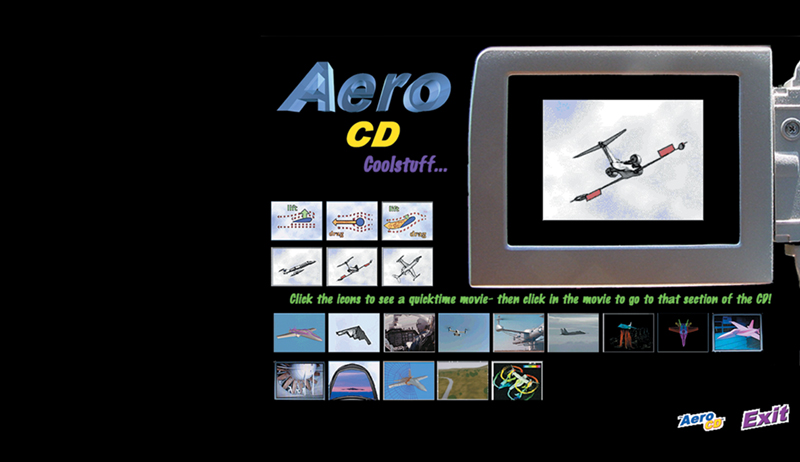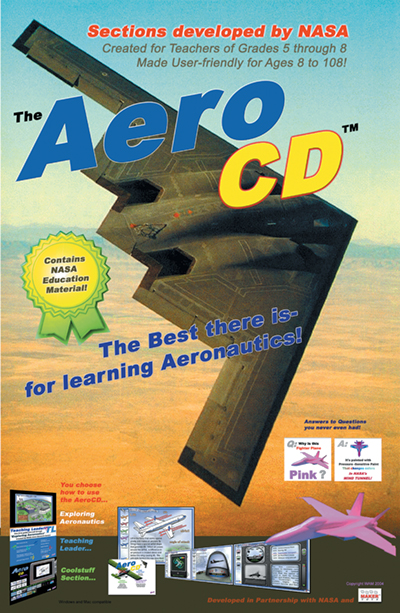
Students Soaring High with Software Spinoff
Originating Technology/ NASA Contribution
An educational software product designed by the Educational Technology Team at Ames Research Center is bringing actual aeronautical work performed by NASA engineers to the public in an interactive format for the very first time, in order to introduce future generations of engineers to the fundamentals of flight.
The “Exploring Aeronautics” multimedia CD-ROM was created for use by teachers of students in grades 5 through 8. The software offers an introduction to aeronautics and covers the fundamentals of flight, including how airplanes take off, fly, and land. It contains a historical timeline and a glossary of aeronautical terms, examines different types of aircraft, and familiarizes its audience with the tools used by researchers to test aircraft designs, like wind tunnels and computational fluid dynamics.
“‘Exploring Aeronautics’ was done in cartoon animation to make it appealing to kids,” notes Andrew Doser, an Ames graphic artist who helped to produce the CD-ROM, along with a team of multimedia programmers, artists, and educators, in conjunction with numerous Ames scientists. In addition to lively animation, the software features QuickTime® movies and highly intuitive tools to promote usage of NASA’s scientific methods in the world of aeronautics.
Partnership
Bill Maecker, the president of Silvercreek, New York-based MakerToys , came to NASA looking for materials and images so that he could create an educational CD-ROM “learning toy” to add to his company’s product line. Ames had a perfect match for Maecker with its “Exploring Aeronautics” CD-ROM, and licensed it to his company. According to Maecker, “It just made sense to license what the educators at Ames called affectionately ‘the Aero CD,’ and the rest is history.”
Product Outcome
MakerToys chose to use “AeroCD” for the name of its spinoff software product. The AeroCD™ retains the graphical user interface developed by Ames as one means to navigate the large amount of material on the CD. As a bonus, the company added two more interfaces to simplify use. The first additional interface, a proprietary “Teaching Leader” component, lets an individual student enjoy the commercial version of the NASA program without direction from a teacher, by providing voice-overs when the student rolls his or her mouse across text on the computer screen. The second additional interface is a “Coolstuff” screen that provides short NASA “movie” samples for users to select and determine if they are interested in continuing on to a particular longer-length QuickTime clip on the disc. The Coolstuff screen is intended to be a simplified navigation tool so that young students do not accidentally skip over important and interesting information stored on the AeroCD.
MakerToys also developed a second CD as a companion to the AeroCD called AeroLP. Its purpose is to provide a database of NASA facts about how things fly for people who want to teach small groups—such as teachers, pilot instructors, and scout leaders—or for individuals who just want to have a reliable information source for their own knowledge. For those who simply want to learn the basics, MakerToys has simplified titles and created a bookmark system for quick access to specific subjects, like aircraft types, classifications of aircraft by speed, and flight regimes, for example. In all, the AeroLP gives users 887 pages of printable material to create their own curricula.
MakerToys has met with numerous science/education distributors, museums, and mass-marketers to create a distribution plan for the AeroCD, thus catering to the needs of the target market. The Evergreen Aviation Museum in McMinnville, Oregon, is one of many U.S. museums raising money to support its programs, tours, and exhibits by selling the AeroCD in its gift shop. Evergreen Aviation Museum isto the “Spruce Goose” Hughes Flying Boat that was built during World War II and tested shortly thereafter. The AeroCD is also available to the general public at the Smithsonian Institution’s National Air and Space Museum, in Washington, DC, where MakerToys’ flying toys have been among the top selling novelty items for years, according to the company.
QuickTime® is a registered trademark of Apple Computer, Inc.
AeroCD™ is trademark of MakerToys.

MakerToys’ AeroCD™ incorporates elements of NASA educational software to introduce students to aeronautics and the fundamentals of flight.

The “Coolstuff” screen provides quick and convenient access to short NASA “movie” samples.













